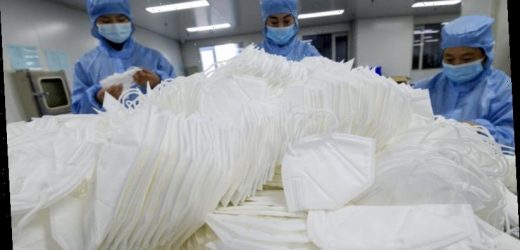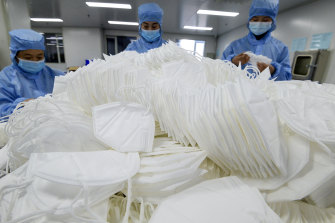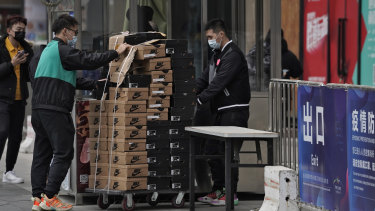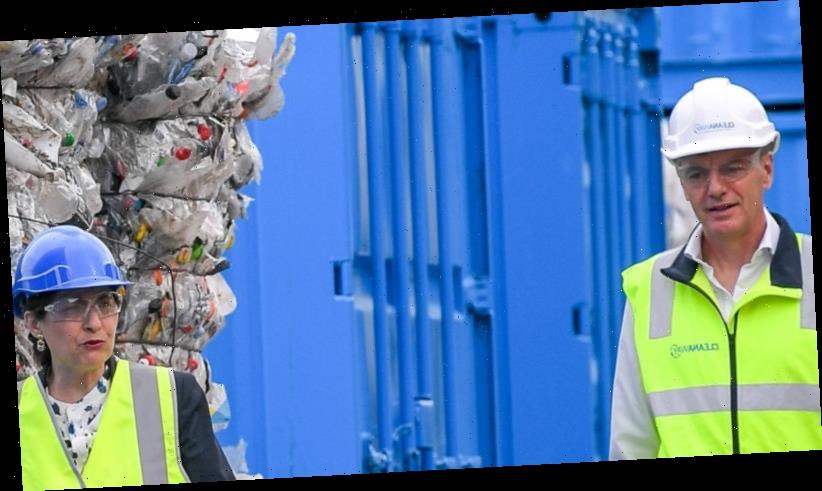Beijing: China's economy picked up speed in the fourth quarter, beating expectations as it ended a rough coronavirus-striken 2020 in remarkably good shape and remained poised to expand further this year even as the pandemic rages unabated.
The world's second-largest economy has surprised many with its quick recovery, especially as policymakers have also had to navigate tense US-China relations on trade and other fronts. Beijing's strict virus curbs enabled it to largely contain the COVID-19 outbreak much faster than most countries, while government-led policy stimulus and local manufacturers stepping up production to supply goods to many countries crippled by the pandemic have also helped fire up momentum.
Workers wearing face masks to protect themselves from the coronavirus arrange the face masks at a factory in Handan, Hebei province, China, in January.Credit:Chinatopix/AP
Gross domestic product (GDP) expanded 6.5 per cent year-on-year in the fourth quarter, data from the National Bureau of Statistics showed on Monday, quicker than the 6.1 per cent forecast by economists in a Reuters poll, and followed an upwardly revised 4.9 per cent growth in the third quarter.
GDP grew 2.3 per cent in 2020, the data showed, making China the only major economy in the world to avoid a contraction last year as many nations struggled to contain the pandemic.
"The higher-than-expected GDP number indicates that growth has stepped into the expansionary zone, although some sectors remain in recovery," Xing Zhaopeng, economist at ANZ in Shanghai.
"Policy exiting will pose counter-cyclical pressures on 2021 growth."
Backed by strict virus containment measures and policy stimulus, the economy has recovered steadily from a steep 6.8 per cent slump in the first three months of 2020, when an outbreak of COVID-19 in the central city of Wuhan turned into a full-blown epidemic.
Workers push a cart loaded with Nike shoes past a security post at a shopping mall in Beijing last week.Credit:AP
Asia's economic powerhouse has been fuelled by a surprisingly resilient export sector, but Chinese consumption – a key driver of growth – has lagged expectations amid fears of a resurgence of COVID-19 cases.
Data last week showed Chinese exports grew by more than expected in December, as coronavirus disruptions around the world fuelled demand for Chinese goods even as a stronger yuan made exports more expensive for overseas buyers.
Yet, underscoring the massive COVID-19 impact worldwide, China's 2020 GDP growth was the weakest pace since 1976, the final year of the decade-long Cultural Revolution that had wrecked the economy.
Overall, the slew of brightening economic data has reduced the need for more monetary easing this year, leading the central bank to scale back some policy support, sources told Reuters, but there would be no abrupt shift in policy direction, according to top policymakers.
On a quarter-on-quarter basis, GDP rose 2.6 per cent in October-December, the bureau said, compared with expectations for a 3.2 per cent rise and a revised 3.0 gain in the previous quarter.
Highlighting the weakness in consumption, retail sales fell 3.9 per cent last year, marking the first contraction since 1968, records from NBS showed. Growth in retail sales in December missed analyst forecasts and eased to 4.6 per cent from November's 5.0 per cent, as sales of garments, cosmetics, telecoms and autos slowed.
However, China's vast manufacturing sector continued to gain momentum, with industrial output rising at a faster-than-expected rate of 7.3 per cent last month from a year ago, hitting the highest since March 2019.
Ning Jizhe, head of China's statistics bureau, told a briefing that there would be many favourable conditions to sustain China's economic recovery in 2021.
"Very strong GDP growth, but domestic demand remains the weakest link. I guess this production-induced recovery will continue in the first quarter of 2021," said Tommy Xie, head of China research at OCBC in Singapore.
"For monetary policy, it is still pretty neutral. The PBOC is always a good trader to manage liquidity very well, so probably status quo for the first half. We are not going to see significant changes."
The Chinese Academy of Social Sciences, a government think tank, sees the macro leverage ratio jumping by about 30 percentage points in 2020 to over 270 per cent.
Analysts expect economic growth to rebound to 8.4 per cent in 2021, before slowing to 5.5 per cent in 2022.
While this year's predicted growth rate would be the strongest in a decade, led by a big jump in the first quarter, it is rendered less impressive coming off the low base set in pandemic-stricken 2020.
Some analysts also cautioned that a recent rebound in COVID-19 cases in China could impact activity and consumption in the run-up to next month's long Lunar New Year holidays.
China reported more than 100 new COVID-19 cases for the sixth consecutive day, with rising infections in the northeast fuelling concerns of another national wave ahead of a major holiday season.
Reuters
Most Viewed in World
Source: Read Full Article




